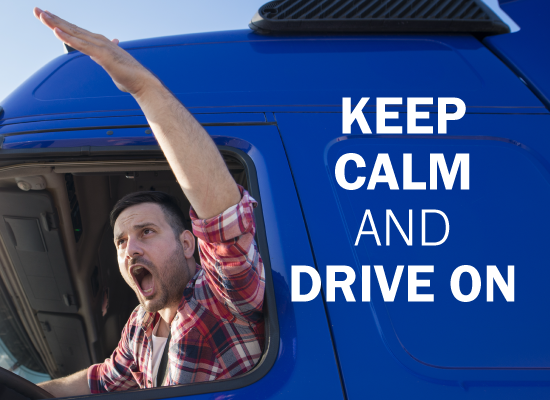
Professional drivers are just that – professionals. But even a professional can find it challenging to stay on schedule and handle the bad driving of others on the road. Do you know how to spot an aggressive driver and how to avoid a road rage situation?
AGGRESSIVE DRIVER BEHAVIORS
Some aggressive driving behaviors are obvious such as using the horn frequently and using rude or obscene hand or facial gestures. Others are more subtle. If you see a driver engaging in these behaviors, you may have an aggressive driver sharing your road.
- Exceeding the speed limit
- Driving too fast for conditions
- Ignoring traffic signs and signals
- Trying to “beat” red lights
- Making erratic lane changes and not signaling intentions
- Weaving in and out of traffic
- Tailgating
- Flashing headlights at slower vehicles
- Using high beams routinely and/or not turning them off for oncoming traffic
- Passing on the right
- Blocking passing lanes
- Cutting others off when changing lanes or passing other vehicles
- Taking the right of way away from others
If you encounter an aggressive driver, there are actions you can take to avoid becoming a target. Remember to respond professionally to aggressive or road rage drivers by:
- Giving them plenty of room
- Letting them pass
- Staying behind them with additional following distance
- Staying calm and not reacting to their behavior
- Not making eye contact with them
- Not engaging in an argument or trying to “teach them a lesson”
- Stopping in a safe place and reporting the driver to authorities, if needed
Staying out of a bad situation is easier if you:
- Obtain adequate rest and healthy nutrition before your trip to help with a healthy mental attitude
- Drive in a courteous and considerate manner
- Obey all traffic laws, signs and signals
- Signal your driving intentions well in advance before turning, passing, etc.
- Check blind spots before turning or changing lanes
- Turn off your high beams for oncoming traffic
- Use your horn sparingly and never in anger
- Stay out of the passing lane if you are not passing another vehicle
- Maintain a safe “space cushion” and at least a seven-second following distance between you and all other vehicles
- Do not confuse a simple driving error by others as road rage. We all make mistakes
- Never tailgate
- Never take your problems with you when you are on the road
- Never permit outside stimuli to negatively affect your driving
- Never assume ill intent on the part of other motorists who may make an honest driving mistake; be forgiving instead
A poster with information on recognizing and avoiding road rage is available for download on the Protective site. Post this in your facility as a reminder for drivers.
Categorized in:
-
Driver Management
-
Driving Techniques
-
Injury Prevention
ClickToAddCategories
No categories have been created yet.
Community
Company Updates
Driver Recruitment
Investor News
Transportation Safety
Claims
Driver Management
Driving Techniques
Distracted Driving
Seasonal Driving Tips
Sharing the Road
Health & Wellness
Injury Prevention
Regulations
Security & Cargo Theft
Vehicle Inspections
Weather Conditions
Workplace Safety
Workers Compensation
Done